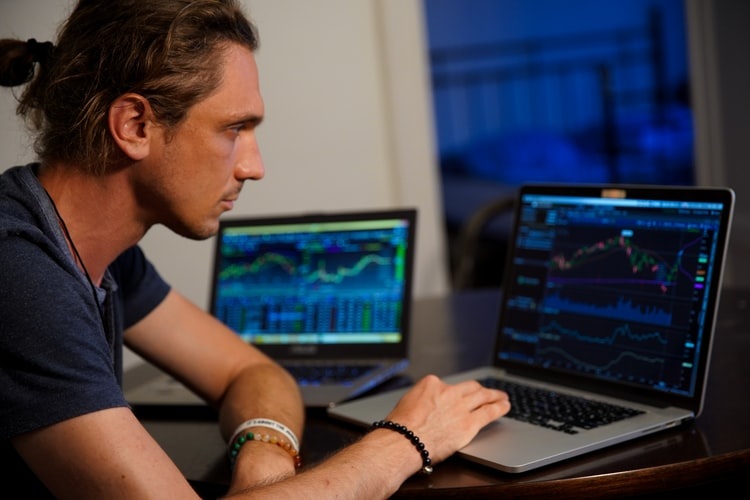A Multi-Account Manager (MAM) trading system enables experienced investors to manage several individually-owned trading accounts. The trades placed by the manager are replicated across the pool of accounts, with characteristics like trade size altered depending on the preferences and risk level set by each investor. This page will detail how MAM trading works, outlining the pros and cons as well as listing the best MAM trading brokers in 2023.
How MAM Trading Works
MAM trading, sometimes shortened to multi-account trading (MAT), entails a master trader or fund manager to carry out trades for multiple users through a single terminal. The managed trading accounts of each investor and individual trader are combined into a large pool that is managed by the master trader. Any orders executed by the MAM trading manager are split amongst the associated accounts as per the risk appetite and available capital of each user.
Master traders utilise software from a MAM trading group or corporation that allows them to execute trades on behalf of their clients and investors. Some of the best MAM software and tools are compatible with industry-recognised platforms, such as MetaTrader 4 (MT4).

Deposits & Withdrawals
Deposits and withdrawals for the individual sub-accounts within a MAM trading pool are handled by the investors and traders themselves; the fund manager cannot request deposits or withdrawals from their clients, they solely manage the trades.
Fees
MAM trading often has associated fees and stipulations, such as minimum deposits.
Minimum deposits can vary from low and accessible to up to tens of thousands for premium packages and more experienced master traders.
MAM trading users pay a fee to the master trader based on their performance, often by way of a percentage of returns. This incentivises the fund manager to be careful with your money and make the best trades. Some master traders also charge management fees to the brokers themselves in the form of an ongoing fixed percentage fee, though this is uncommon.
MAM Trading Example
The best way to conceptualise and understand MAM trading is to run through an example.
Suppose you invest $20,000 into a MAM forex trading account and you are allocated or have selected an experienced trader with a swing trading strategy.
If the first week’s investments earn you 30% gains, by the end of that week your balance will sit at $26,000 ($20,000 x 30% = $6,000).
However, the MAM trading manager will take a commission from these profits, for example, 20%. As a result, the fund manager would take $1,200 ($6,000 x 20% = $1,200) from your profits, leaving you with a final balance of $24,800 after the week’s trading, giving you a net profit of $4,800.
MAM Trading Strategies
Master traders execute trades either by equity size or lot allocation.
Equity Size
An example of equity size MAM trading management is as follows. Consider a multi-account manager that has five investors with a range of investment sizes totalling $50,000.
The MAM trading manager could execute a 10-lot position on EUR/USD in the master terminal.
The respective trades of each investor would then be:
- Investor 1: $12,000/$50,000 * 10 = 2.4 lots
- Investor 2: $15,000/$50,000 * 10 = 3 lots
- Investor 3: $5,000/$50,000 * 10 = 1 lot
- Investor 4: $10,000/$50,000 * 10 = 2 lots
- Investor 5: $8,000/$50,000 * 10 = 1.6 lots
- Total number of lots: 10

Lot Allocation
For lot allocation, the trades are split by the proportion of lots each trader makes available. For example, consider two active sub-accounts within a MAM trading pool that have lot allocations of 2 and 3 lots, respectively.
If the master trader again makes a 10-lot trade, the trading volume for each sub-account would be:
- Investor 1: 2/5 * 10 = 4 lots
- Investor 2: 3/5 * 10 = 6 lots
As you can see, it is a very similar approach to equity size MAM trading, only the investors put forward relative trade sizes rather than specific equity amounts.
MAM Vs PAM Vs LAM
There are some key differences between Multi-Account Manager (MAM) trading, Percentage Allocation Management (PAM) and Lot Allocation Management (LAM) solutions.
PAM terminals enable investors to allocate a portion (as a percentage) of their total trading capital to copy trades from a master.
also allow you to follow multiple traders and diversify your portfolio by allocating different percentages to different investors.
On the other hand, gives the power to the investor to choose the number of lots that can be traded by various master investors. is essentially a more basic version of that aim to lower the risk of trading losses.
Pros Of
There are several advantages to :
- Transparent form of investment
- Range of account types available, usually Full, Mini and Micro
- Provides several levels of control for both the trader and investor
- There are no restrictions on the number of trading accounts and deposit quantities
- Simple and time-efficient as you don’t need to watch and actively analyse the market yourself
- Client portions can begin at 0.01 (1000 units) lots per trade, which is accessible for those with less capital to invest at once
Cons Of
Despite the benefits, there are a few disadvantages to :
- It can be difficult to interpret the records of a without high-level tools
- It can be challenging for a to calculate the correct number of lots to be allocated, especially when there is a big difference in the balance or equity size of individual user contributions, sometimes leading to disproportionate trade shares for larger accounts
- If the master trader opens a 0.01 lot position this will usually only be allocated to the individual trading account with the greatest balance or equity
- Dishonest investors might steal or replicate the strategy of , largely by copying the trades in real-time in their own, separate account
How To Start
To start you first need to find a suitable .
When selecting a provider, there are several crucial aspects to take into consideration:
- Fees – The fees charged by MAM trading firms can vary, so make sure that you are comfortable with the fee structure and that the minimum deposit is feasible. Also, watch out for any hidden fees and charges for deposits or withdrawals.
- Regulation – Regardless of the trading style, it is always recommended to choose a provider that is regulated by an independent body, such as the FCA in the UK. This will help safeguard you from scams, ensure the safety of your money, and provide you with legal remedies in the event of unethical practices.
- Platform – Most MAM trading solutions employ MT4, though some may use a different platform or a customized service.
- Demo – Try out a provider first by utilizing a demo solution. Paper trading accounts allow you to assess the platform and firm, ensuring that it is the best fit for your requirements before committing. This is all done in a safe, simulated environment with real-time market conditions but no actual capital.
- Requirements – The requirements will vary depending on each MAM trading brokerage. Everything from minimum deposits to geographical availability can differ. For example, if you are seeking a MAM solution for international trading, ensure that this option is available to you.
- Master trader – The risk factor of MAM trading will primarily depend on the profitability of the master trader, similar to investing in a hedge fund or a ready-made investment portfolio.
While managers are often experienced, it’s important to do your research. See if you can find any trade history of the prospective master trader running the MAM solution.

Final Word On MAM Trading
MAM trading offers several benefits to both new and experienced traders. Primarily, the fact that your trades are managed for you means that beginners may earn solid profits from the markets without needing to overcome a large learning curve. Similarly, MAM trading requires very little active management, perfect for traders with little extra time on their hands. But while MAM trading also offers several levels of control for both traders and investors, there are still risks involved and you should always ensure that the company is fully regulated with transparent trading history.
FAQs
What Is MAM Trading?
Multi-Account Manager (MAM) trading allows an experienced investor to perform trades for several users through a single terminal. Individual traders put forward capital and the master trader carries out trades that are replicated for all accounts in the pool.
What Is The Difference Between MAM Trading And PAM Trading?
Multi-Account Manager (MAM) trading gives the master trader flexibility in the position size allocated to sub-accounts. Percentage Allocation Management (PAM) trading allocates positions to sub-accounts based on the size of their investment relative to the total pooled equity.
How Does MAM Trading Work?
Multi-Account Manager (MAM) trading merges individual accounts and investor accounts into a large pool that essentially becomes a managed fund.
Any trades the master trader makes will be replicated across the sub-accounts based on the risk level and preferences set by each investor.
Do You Need A License To Become A MAM Master Trader?
Forex traders do not require licenses but MAM forex brokers do. This means established investors can become master traders with reputable providers if they can demonstrate strong trading history.
What Does MAM Trading Stand For?
MAM stands for Multi-Account Management. MAM software enables a master trader, or fund manager, to manage a large number of individual accounts through one terminal.
